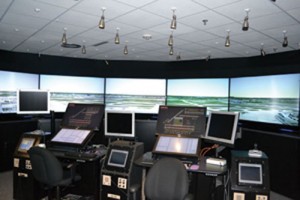The most intense use of the US Federal Aviation Administration’s NextGen Integration and Evaluation Capability (NIEC) to date has been by the UAS community, both within the FAA and the broader government and industry community.
The NIEC was created so that neither next-generation air transport system’s avionics component nor new procedures for the National Airspace System (NAS) should be tested in real time. It is located at the agency’s William J Hughes technical centre at Atlantic City international airport.
The basic question being addressed is what it takes to fly an unmanned aircraft in national airspace. With six studies completed, officials are accumulating experience. One piece of software kit – a “stop light” – was developed for a study looking into how military UAS controllers and FAA air traffic controllers could better co-ordinate occasions where a remotely piloted vehicle must traverse civil airspace en route to a practice area.
Simulations use actual or software-simulated UAS ground control stations integrated into the NIEC as well as links to various NAS elements for the human-in-the-loop studies. To date, there are three ground control stations integrated into the NIEC: the AAI Shadow 200, the General Atomics Predator and the Boeing ScanEagle.
For the Cherry Point Marine Corps air station simulation with the Shadow 200, the FAA developed a traffic light indicator for controller displays based on the projected path of the unmanned aircraft vehicle ahead in time. The idea was to give controllers a light-coded alert that would provide ample time to make UAV flight-path corrections during a certain airspace transition to avoid civil aircraft not in contact with air traffic controllers. As with a traffic light, a green indicator on the screen signalled a nominal transition: yellow indicated a potential collision concern with other aircraft, and red an imminent hazard.
The UAS efforts are becoming increasingly sophisticated. Along with human-in-the-loop studies with a flight management system-equipped Shadow 200 capable of flying 4D trajectories set for later this year, the NIEC will also host an operational assessment of “multi-UAS” operation focused on Victorville, California.
Along with the NIEC tower simulator and Predator UAS ground station, the simulation will introduce an AeroVironment Raven UAS, Boeing Hummingbird rotorcraft UAS and an airship, all flying in the simulated control tower environment. “The goal is to assess the feasibility of simultaneously operating multiple UAS in a joint-use military/civilian class D air traffic environment,” says the FAA.

Elements of the laboratory, which has been open for business since June 2010, include a simulated air traffic control tower with a 270° “outside” view (eventually to be 360°), terminal and en route air traffic controller workstations, unmanned aircraft system ground stations, desktop computer “pseudo” pilot workstations and a fixed-base cockpit simulator for human-in-the-loop studies.
Feeding the various simulators with realistic or real data are a variety of home-grown hardware and software suites that bring in weather, communications or surveillance data from other FAA laboratories or from the actual NAS. “The reason we built this lab is to give the opportunity for principal investigators to take a NextGen technology and introduce it so you can see the ripple effect across the NAS,” says Hilda DiMeo, NextGen and operations planning director for the centre.
Ongoing or completed projects demonstrate the capabilities much better than any brochure. This summer the NIEC will continue testing of an FAA project to determine what tools controllers would need to someday “man” control towers from remote locations. During two simulation sessions, investigators and engineers have progressively built the technologies and procedures that are part of the “staffed next generation tower” project.
Elements of the project include a Massachusetts Institute of Technology-developed traffic information display system and tower flight data management system (an electronic version of paper flight strips) for controllers, and a variety of front- and back-end systems that the FAA built to allow controllers to see aircraft on the tower displays and out of the simulated tower cab windows. Standard procedure is to bring in one group of FAA controllers to develop the scenarios and a second group to take part in the simulated scenarios.
Source: Flight Global

Interesting study, technologically- with all the recent press and news about controller fatigue it would be a great time to see if you can measure the difference in reponsiviness to similar control situations with a shift work sceniro. The remote portion maybe more sensitive if fatigued. Is there also an opportunity to do an evaluation of colors, observable and depth perception of different colors and background. Performance variability and controller knowledge of aircraft types I assume is part of the taining benchmark.